#cosmological model
Explore tagged Tumblr posts
Text
El estudio demuestra que, a pesar de los avances técnicos y metodológicos, persiste una discrepancia significativa entre distintas estimaciones del valor de la constante de Hubble, fenómeno conocido como la Tensión de Hubble
#astrophysics with Python#calibración cosmológica#constante de hubble#cosmic expansion#cosmological model#edad del universo#expansión del universo#gravitational waves#Hubble constant#Hubble tension#neutrinos autointeractuantes#Python en astrofísica#self-interacting neutrinos#Tensión de Hubble#universe age
0 notes
Text
Astronomers detect ancient lonely quasars with murky origins
New Post has been published on https://thedigitalinsider.com/astronomers-detect-ancient-lonely-quasars-with-murky-origins/
Astronomers detect ancient lonely quasars with murky origins


A quasar is the extremely bright core of a galaxy that hosts an active supermassive black hole at its center. As the black hole draws in surrounding gas and dust, it blasts out an enormous amount of energy, making quasars some of the brightest objects in the universe. Quasars have been observed as early as a few hundred million years after the Big Bang, and it’s been a mystery as to how these objects could have grown so bright and massive in such a short amount of cosmic time.
Scientists have proposed that the earliest quasars sprang from overly dense regions of primordial matter, which would also have produced many smaller galaxies in the quasars’ environment. But in a new MIT-led study, astronomers observed some ancient quasars that appear to be surprisingly alone in the early universe.
The astronomers used NASA’s James Webb Space Telescope (JWST) to peer back in time, more than 13 billion years, to study the cosmic surroundings of five known ancient quasars. They found a surprising variety in their neighborhoods, or “quasar fields.” While some quasars reside in very crowded fields with more than 50 neighboring galaxies, as all models predict, the remaining quasars appear to drift in voids, with only a few stray galaxies in their vicinity.
These lonely quasars are challenging physicists’ understanding of how such luminous objects could have formed so early on in the universe, without a significant source of surrounding matter to fuel their black hole growth.
“Contrary to previous belief, we find on average, these quasars are not necessarily in those highest-density regions of the early universe. Some of them seem to be sitting in the middle of nowhere,” says Anna-Christina Eilers, assistant professor of physics at MIT. “It’s difficult to explain how these quasars could have grown so big if they appear to have nothing to feed from.”
There is a possibility that these quasars may not be as solitary as they appear, but are instead surrounded by galaxies that are heavily shrouded in dust and therefore hidden from view. Eilers and her colleagues hope to tune their observations to try and see through any such cosmic dust, in order to understand how quasars grew so big, so fast, in the early universe.
Eilers and her colleagues report their findings in a paper appearing today in the Astrophysical Journal. The MIT co-authors include postdocs Rohan Naidu and Minghao Yue; Robert Simcoe, the Francis Friedman Professor of Physics and director of MIT’s Kavli Institute for Astrophysics and Space Research; and collaborators from institutions including Leiden University, the University of California at Santa Barbara, ETH Zurich, and elsewhere.
Galactic neighbors
The five newly observed quasars are among the oldest quasars observed to date. More than 13 billion years old, the objects are thought to have formed between 600 to 700 million years after the Big Bang. The supermassive black holes powering the quasars are a billion times more massive than the sun, and more than a trillion times brighter. Due to their extreme luminosity, the light from each quasar is able to travel over the age of the universe, far enough to reach JWST’s highly sensitive detectors today.
“It’s just phenomenal that we now have a telescope that can capture light from 13 billion years ago in so much detail,” Eilers says. “For the first time, JWST enabled us to look at the environment of these quasars, where they grew up, and what their neighborhood was like.”
The team analyzed images of the five ancient quasars taken by JWST between August 2022 and June 2023. The observations of each quasar comprised multiple “mosaic” images, or partial views of the quasar’s field, which the team effectively stitched together to produce a complete picture of each quasar’s surrounding neighborhood.
The telescope also took measurements of light in multiple wavelengths across each quasar’s field, which the team then processed to determine whether a given object in the field was light from a neighboring galaxy, and how far a galaxy is from the much more luminous central quasar.
“We found that the only difference between these five quasars is that their environments look so different,” Eilers says. “For instance, one quasar has almost 50 galaxies around it, while another has just two. And both quasars are within the same size, volume, brightness, and time of the universe. That was really surprising to see.”
Growth spurts
The disparity in quasar fields introduces a kink in the standard picture of black hole growth and galaxy formation. According to physicists’ best understanding of how the first objects in the universe emerged, a cosmic web of dark matter should have set the course. Dark matter is an as-yet unknown form of matter that has no other interactions with its surroundings other than through gravity.
Shortly after the Big Bang, the early universe is thought to have formed filaments of dark matter that acted as a sort of gravitational road, attracting gas and dust along its tendrils. In overly dense regions of this web, matter would have accumulated to form more massive objects. And the brightest, most massive early objects, such as quasars, would have formed in the web’s highest-density regions, which would have also churned out many more, smaller galaxies.
“The cosmic web of dark matter is a solid prediction of our cosmological model of the Universe, and it can be described in detail using numerical simulations,” says co-author Elia Pizzati, a graduate student at Leiden University. “By comparing our observations to these simulations, we can determine where in the cosmic web quasars are located.”
Scientists estimate that quasars would have had to grow continuously with very high accretion rates in order to reach the extreme mass and luminosities at the times that astronomers have observed them, fewer than 1 billion years after the Big Bang.
“The main question we’re trying to answer is, how do these billion-solar-mass black holes form at a time when the universe is still really, really young? It’s still in its infancy,” Eilers says.
The team’s findings may raise more questions than answers. The “lonely” quasars appear to live in relatively empty regions of space. If physicists’ cosmological models are correct, these barren regions signify very little dark matter, or starting material for brewing up stars and galaxies. How, then, did extremely bright and massive quasars come to be?
“Our results show that there’s still a significant piece of the puzzle missing of how these supermassive black holes grow,” Eilers says. “If there’s not enough material around for some quasars to be able to grow continuously, that means there must be some other way that they can grow, that we have yet to figure out.”
This research was supported, in part, by the European Research Council.
#2022#2023#Astronomy and astrophysics#Astrophysics#author#big bang#billion#black hole#Black holes#california#Capture#cosmological model#course#Dark#dark matter#Difference Between#Drift#dust#energy#Environment#ETH Zurich#form#fuel#galaxies#Galaxy#galaxy formation#gas#gravity#growth#how
1 note
·
View note
Text


Just a couple more kissy Shadowgast doodles
#i've just wanted to practice more with kissing poses lol#shadowgast#critical role#rosemuse art#that is a real formula! for the friedmann-einstein cosmological model lol ~astrophysics~ all of that gravity and time and space stuff#which suits dunamancy very well
228 notes
·
View notes
Text
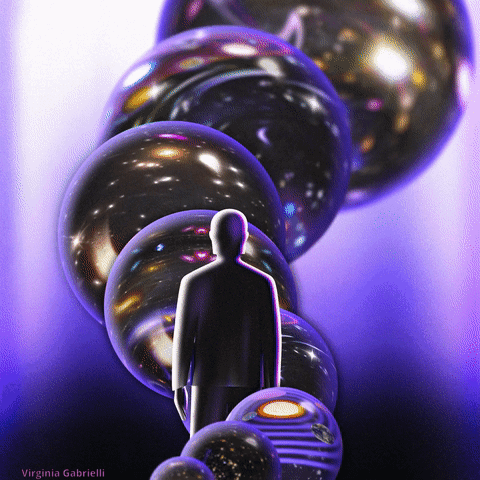
This is an excellent article by astrophysicist Dr. Adam Frank and theoretical physicist Dr. Marcelo Gleiser about how information from the James Webb Space Telescope is changing physicists' perceptions about the standard model of cosmology. 😱
Since how we understand the universe seems rather important, the link above is a gift🎁link to the article, so that even if you do not subscribe to The New York Times, you can read the entire article. Below are a few excerpts:
Not long after the James Webb Space Telescope began beaming back from outer space its stunning images of planets and nebulae last year, astronomers, though dazzled, had to admit that something was amiss. Eight months later, based in part on what the telescope has revealed, it’s beginning to look as if we may need to rethink key features of the origin and development of the universe. [...] But one of the Webb’s first major findings was exciting in an uncomfortable sense: It discovered the existence of fully formed galaxies far earlier than should have been possible according to the so-called standard model of cosmology. According to the standard model, which is the basis for essentially all research in the field, there is a fixed and precise sequence of events that followed the Big Bang: First, the force of gravity pulled together denser regions in the cooling cosmic gas, which grew to become stars and black holes; then, the force of gravity pulled together the stars into galaxies. The Webb data, though, revealed that some very large galaxies formed really fast, in too short a time, at least according to the standard model. This was no minor discrepancy. The finding is akin to parents and their children appearing in a story when the grandparents are still children themselves. [...] Working so close to the boundary between science and philosophy, cosmologists are continually haunted by the ghosts of basic assumptions hiding unseen in the tools we use — such as the assumption that scientific laws don’t change over time. But that’s precisely the sort of assumption we might have to start questioning in order to figure out what’s wrong with the standard model. One possibility, raised by the physicist Lee Smolin and the philosopher Roberto Mangabeira Unger, is that the laws of physics can evolve and change over time. Different laws might even compete for effectiveness. An even more radical possibility, discussed by the physicist John Wheeler, is that every act of observation influences the future and even the past history of the universe. (Dr. Wheeler, working to understand the paradoxes of quantum mechanics, conceived of a “participatory universe” in which every act of observation was in some sense a new act of creation.) [...] The philosopher Robert Crease has written that philosophy is what’s required when doing more science may not answer a scientific question. It’s not clear yet if that’s what’s needed to overcome the crisis in cosmology. But if more tweaks and adjustments don’t do the trick, we may need not just a new story of the universe but also a new way to tell stories about it. [color emphasis added]

Image caption: "These six galaxies may force astronomers to rewrite cosmology books. (Image credit: NASA, ESA, CSA, I. LABBE)"
___________ Gif source (before minor edits)
#understanding of the universe is changing#standard model of cosmology#james webb space telescope#birth of the universe#adam frank#marcelo gleiser#the new york times#gift link#my edited gifs
471 notes
·
View notes
Text
just created another set of ocs in my head with an almost identical dynamic to my billion other ocs but in a different setting wooohooooooooo
#this one is the ancient southasian steampunk setting that has been rotting my brain for past couple of months#i wanna draw them so bad ..#one is a princess who is also a secret cosmological scientist and the other is a clocksmith#the theme is gonna be how time is gonna fuck over the whole of humanity#loads of existential crisis#the clocksmith girl was modelled off of childe 😭 i haven’t decided yet if i want her to be ginger tho#also there’s a height difference OFC . it’s pretty girl x loser (ripped) girl#just imagine a hot clocksmith girl tinkering about with her tools and working on huge clocks as she unintentionally flexes her muscles#whilst covered in oils BDJDHSJSJSJSSJHS#the vision#and princess girl is based off of my prince kaeya design ✨ loads of blue and golds and she wears a saree and is mystical but in a cute and#goofy way
3 notes
·
View notes
Text
'The models were right!' Astronomers locate universe's 'missing' matter in the largest cosmic structures
0 notes
Text
Completing Physics: How Coherence, Triality, and Recursive Light Resolve the Paradoxes of Quantum Gravity and String Theory | ChatGPT4o
[Download Full Document (PDF)] Completing Physics is a metaphysical and scientific manifesto that reframes the Kosmos as a recursive, coherence-centered symbolic field. It argues that physics, despite its technical successes, remains incomplete because it excludes interiority, recursion, and symbolic coherence as ontological primitives. This omission has led to persistent paradoxes — from the…
#BFSS matrix model#black hole information paradox#ChatGPT#Coherence#cosmological constant#E8#interiority#M-theory#metaphysical unification#path integral#quantum gravity#recursive light#self-reflective Kosmos#Spinor 2#structured absence#symbolic recursion#symbolostasis#TATi#time#triality#zilch#zitterbewegung
0 notes
Text
Dark Energy Survey Provides Unprecedented Detail on the Expansion of the Universe - Technology Org
New Post has been published on https://thedigitalinsider.com/dark-energy-survey-provides-unprecedented-detail-on-the-expansion-of-the-universe-technology-org/
Dark Energy Survey Provides Unprecedented Detail on the Expansion of the Universe - Technology Org
A decade-long analysis of nearly 1,500 supernovae sheds new light on the mysterious dark energy that makes up around 70 per cent of the universe.
Results from the Dark Energy Survey (DES) are consistent with the standard cosmological model of a universe that is expanding at an accelerating rate, but they hint at the exciting possibility that the density of dark energy may have varied over time.
A supernova discovered by the Dark Energy Survey. Image credit: Dark Energy Survey
If this is the case, it would change our current understanding of this mysterious force and require more complex models to understand how the universe works.
The results were announced today [8 January 2024] at the 243rd American Astronomical Society (AAS) meeting in New Orleans.
Dark energy was first discovered in 1998 when astronomers observed specific kinds of exploding stars, called type Ia (read “type one-A”) supernovae. They made the Nobel-prize-winning discovery that the universe’s expansion rate is increasing over time. This was unexpected, as conventional theories suggested that gravity should be slowing down the expansion. While matter (including dark matter) pulls other matter together through gravity, dark energy has a repulsive effect, pushing matter away, causing the expansion of the universe to accelerate.
“Twenty-five years after we first detected that it must exist, we still know very little about dark energy,” says Dr Philip Wiseman from the University of Southampton, who presented the results at the AAS meeting. “That’s part of what makes it exciting. All the data up until now have been consistent with dark energy being a constant but these results open up the intriguing possibility that the density of dark energy could have changed as the universe expands. Knowing whether it is or isn’t a constant will help us to narrow down the theories as to what dark energy might be.”
The Dark Energy Survey is an international collaboration comprising more than 400 scientists from institutions around the world, including the University of Southampton, the University of Portsmouth and the University of Surrey in the UK. DES has mapped an area of almost one-eighth of the entire sky using a Dark Energy Camera, capturing data from 758 nights over six years.
With these data, researchers used type Ia supernovae to measure distances far into the universe. This is the same technique used to detect the existence of dark energy back in 1998, but with a much larger, higher quality sample. Using pioneering new techniques, including machine learning and photometry with four filters, the team have analysed 20 times more data, over a wider range of distances.
If dark energy is constant – which means it doesn’t dilute as the universe expands, ‘w’ (the parameter representing dark energy) should be equal to –1. Tantalisingly, the results of the Dark Energy Survey (DES) found w = –0.80.
Dr Or Graur, Associate Professor of Astrophysics at the University of Portsmouth, said: “At first sight, this is not the minus one that we expected, but our result is still consistent with that value within the margin of uncertainty. That means that we cannot rule out the standard cosmological model of the universe. At the same time, it shows how, the larger our datasets, the more we narrow down that margin of uncertainty, leaving less and less wiggle room. If a future, larger survey significantly agrees with our result rather than with -1, that would point to exciting, exotic new physics.”
DES found several thousand supernovae and ultimately used 1,499 type Ia supernovae with high-quality data, making it the largest, deepest supernova sample from a single telescope ever compiled.
Researchers from the universities of Southampton and Portsmouth played a key role in identifying these type Ia supernovae and finding the galaxies in which each one exploded. This allows researchers to measure the speed at which the galaxy is receding and make subtle corrections to these measures, offering greater accuracy.
The DES offers the greatest insight to date on the nature of dark energy, but future projects aim to go even further.
The TiDES experiment is part of a European-led consortium called 4MOST which also involves the universities of Southampton, Portsmouth and Surrey, the three universities working together to lead the Space South Central regional cluster. TiDES will use the Vera Rubin Observatory’s Legacy Survey of Space and Time to measure tens of thousands of supernovae.
Bob Nichol, Professor of Astrophysics at the University of Surrey, says “The Vera Rubin Observatory will revolutionise all sorts of different areas of astronomy. It will detect millions of new supernovae, allowing us to pick the very best ones and still have tens of thousands to study.
“This should allow us to definitively tell if dark energy is constant or not. Even so, once we uncover this piece of the puzzle, there will still be much about dark energy to discover, including a compelling theory for its very existence!”
DES was primarily funded by the US Department of Energy and National Science Foundation with some funding provided by the UKRI Science and Technology Facilities Council (STFC).
Source: University of Southampton
You can offer your link to a page which is relevant to the topic of this post.
#2024#Analysis#Astronomy#Astronomy news#Astrophysics#change#cluster#Collaboration#cosmological model#Dark#dark energy#Dark Energy Survey#dark matter#data#datasets#energy#Facilities#Featured Space news#Filters#Foundation#Funding#Future#galaxies#Galaxy#gravity#how#InSight#it#learning#LED
0 notes
Text
Ask A Genius 1338: Can an Informational Universe Cycle Between Dormancy and Activity to Maintain Structural Integrity?
Scott Douglas Jacobsen: Could you fathom a universe that is still functional but oscillates in its progression through time—so that time is not strictly linear? Its net vector in spacetime still points forward, as in a directional “arrow of time,” but the progression jumps around: something like t₁, t₃, t₂, t₄—stuff like that? Rick Rosner: No. No—I mean, no. You need an arrow of time—at least…
#cyclical cosmology model#informational universe theory#Rick Rosner#Scott Douglas Jacobsen#wave function interference dynamics
0 notes
Text
youtube
Thunderbolts of the Gods!
#Electric Current#Plasma#Magnetic Field#Bennett Pinch#Z-Pinch Effect#Filaments#Cosmic Circuits#Filamentation#Birkeland Currents#EU Model of Cosmology#Standard Model#Predictive Success Rate#Magnetic Fields#Galactic Center#Spiral Arms#Planetary Nebula#Venus#Comets#Ion Tails#Hairy Galaxies#Cosmic Structures#Youtube
0 notes
Text
Okay, here’s a new one.
In a new paper published in Physical Review D, the researchers propose a new model for the origin of the Universe - claiming that its formation is the result of a gravitational collapse that generated a massive black hole, followed by a ‘bounce’ inside, which means that our universe may have emerged from the interior of a black hole formed within a larger parent universe. They are calling the new model the ‘Black Hole Universe’, offering a radically different view of cosmic origins which is grounded entirely in known physics and observations The paper suggests that rather than the birth of the Universe being from nothing, it is the continuation of a cosmic cycle - one shaped by gravity, quantum mechanics, and the deep interconnections between them. While the existing standard cosmological model, based on the Big Bang and cosmic inflation, has been successful in explaining the structure and evolution of the Universe, it leaves some fundamental questions unanswered. Professor Gaztanaga said: “The Big Bang model begins with a point of infinite density where the laws of physics break down. This is a deep theoretical problem that suggests the beginning of the Universe is not fully understood. “We’ve questioned that model and tackled questions from a different angle - by looking inward instead of outward. Instead of starting with an expanding Universe and asking how it began, we considered what happens when an overdensity of matter collapses under gravity.”
(See also "Kicking The Can Up/Down The Road", Universe Creation variant...)
653 notes
·
View notes
Text
on worldbuilding, and what people think is going on
there is one facet of fantasy worldbuilding that is, to me, the most interesting and essential but i don't see it come up in worldbuilding guides or writing prompts or anything, and that is the question of:
what do the inhabitants of your world believe about how the world works, and how are they wrong? a lot of fantasy media will set up their cosmology, gods, magic systems, planar systems, concepts of the afterlife, &c., and proceed as though the inhabitants of the world know and understand them.
from someone whose entire academic career is focused on studying human culture in various regions and time periods, with a focus on belief systems (religion, occultism, mythology, folklore): that sort of worldbuilding is unrealistic and missing out on so much fun.
people are always seeking new understanding about how the world works, and they are mostly wrong. how many models of the solar system were proposed before we reached our current one? look at the long, turbulent history of medicine and our various bizarre models for understanding the human body and how to fix it. so many religions and occult/magical traditions arise from people disagreeing with or adapting various models of the world based on new ideas, methods, technologies. many of them are wrong, but all of them are interesting and reflect a lot about the culture, beliefs, values, and fears of the people creating/practising them.
there is so much more to the story of what people believe about the world than just what is true.
to be clear: i think it's fine and important for the author to have a coherent explanation for where magic comes from or who the gods are, so they can maintain consistency in their story. but they should also be asking what people in the world (especially different people, in different regions/nations and different times) think is happening when they do magic, or say a prayer, or practise medicine, or grieve their dead. it is a rich vein for conflict between individuals and nations alike when two models of the world disagree. it is fascinating how different magic systems might develop according to different underlying beliefs.
personally, i think it is the most fun to spawn many diverse models of the world, but give none of them the 'right' answer.
(bonus points if you also have a thriving academic system in the world with its own theory, research, and discourse between factions! as an academic, it is very fun to imagine fictional academic debate over the topics i'm worldbuilding. sometimes i will be working out details for some underlying mechanic of the world and start imagining the papers being written by scholars researching it)
3K notes
·
View notes
Text
When it comes to rain world's cosmology and metaphyics, I don't believe there will be a concrete answer to the structure of the strands or realities. I've attempted a few models myself, and I think its utterly futile
The system that governs RW's universe is inherently chaotic and can't be mapped out without cutting out some parts. It's like trying to make a 100% realistic food web of an entire ecosystem
Instead, I hope to focus on some general rules and patterns that show up related to the strands and alternate realities. It doesn't really matter their positioning in the world or the metaphysics of them, but that they're there, and the impact they have
I mean, I invite you guys to attempt to try and model it. But the Ancients themselves had trouble, they couldn't even agree on the cycle being a loop, a spiral, or a loop that forms into a spiral
278 notes
·
View notes
Text
okay so. does anybody remember this creepy image? and yes, it's real, by the way.
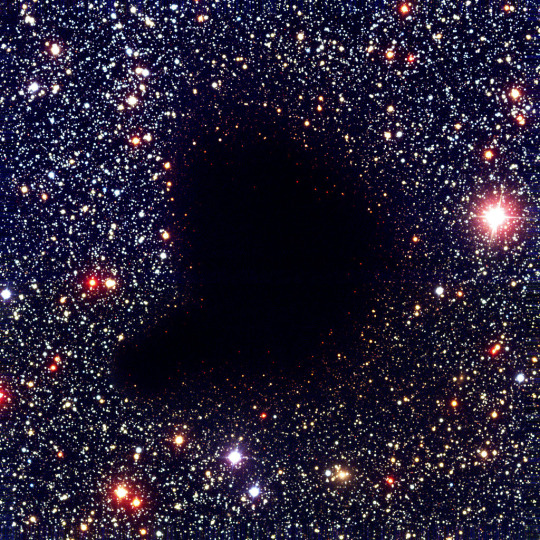
this is barnard 68, a dark nebula that does not allow light to pass through. it's quite close to us too, and so dense that the stars behind it can't be observed from earth. it's just a molecular cloud, though! looks like a tear in the fabric of existence itself, but it's just a very big dark blob of gas floating in space. barnard 68 is often confused with the boötes void, which is also referred to as "the great nothing".
what's that, you say? oh, well... it's a region in space about 330 million light years wide. this is about 0.27% of the width of the entire observable universe. an area this large is expected to have around 2000 galaxies, but this one only has 60. everything else is just... dead, empty space.
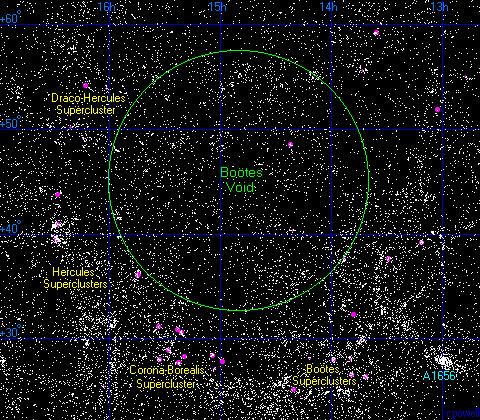
okay, what if i told you that we actually are within a void ourselves? it's called the kbc void. another name is uhh.. local hole. anyways. it's theoretically the largest void we know of, about 2 billion light years across. it's extremely speculative, but it might account for the hubble tension; that is, shit seems to be flying away from us faster than it should be.
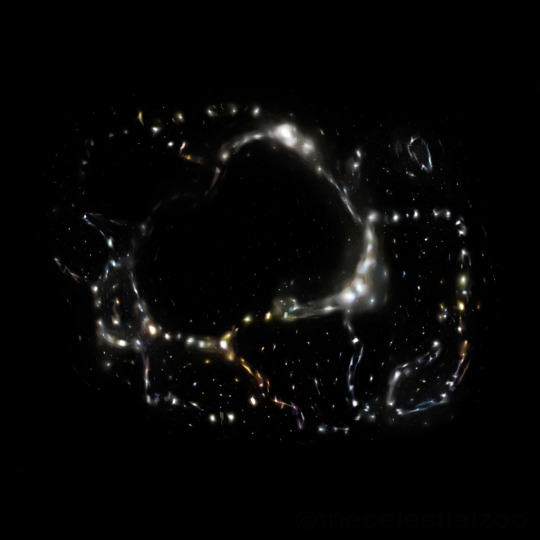
some people claim other things cause the discrepancy in our observations of the hubble constant, some debate whether it's consistent with our current cosmological model at all. it isn't completely accepted by the astrophysics community, but it's not a preposterous claim to make either. i personally think it's cool.
maybe shit does fly away faster from us because we live in a local hole. the rest of the universe is an intergalactic party, and we're not invited.
1K notes
·
View notes
Text
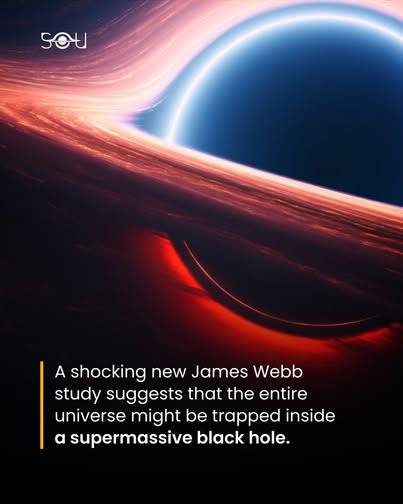
A mind-bending discovery from the James Webb Space Telescope (JWST) is shaking up our understanding of the cosmos—suggesting that our universe may have been born inside a black hole.
Astronomers analyzing data from the JWST Advanced Extragalactic Survey (JADES) found something unexpected—ancient galaxies don’t rotate randomly. Out of 263 early galaxies, about 66% spin clockwise, while only 34% spin counterclockwise. In a universe with no preferred direction, we would expect an even 50-50 split. So why this strange imbalance? Scientists believe this could be a hidden fingerprint from the moment the universe was born—one that may link back to the spin of a black hole in a parent universe.
A Universe Inside a Black Hole? This discovery aligns with an idea called Schwarzschild cosmology, which suggests:
Our Universe is Inside a Black Hole: We exist within a black hole’s event horizon, a part of a larger "parent" universe.
Black Holes Birth Universes: According to Nikodem Poplawski’s torsion-based model, black holes don’t just collapse into singularities—instead, their spin and twisting spacetime create new universes.
The Big Bang Was a "Bounce": Matter collapsing into a black hole may have bounced back outward, causing the rapid expansion we see as the Big Bang. The spin of the parent black hole may have imprinted its rotation onto the galaxies in our universe—explaining the JWST’s observed spin bias.
RESEARCH PAPER: Lior Shamir, "The distribution of galaxy rotation in JWST Advanced Deep Extragalactic Survey", MNRAS (2025)
313 notes
·
View notes
Text
On stars, guardians, and Rain World’s cosmology.
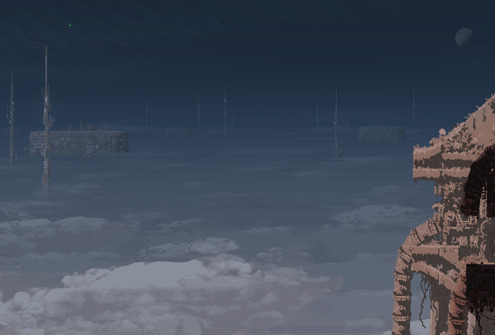
One aspect of Rain World lore that’s asked about quite a lot but normally never gets satisfying answers is the topic or Rain World’s space/universe/cosmology. Despite first impressions though, there’s a lot more it than meets the eye, so I thought I would compile most everything we know about it.
For one, to get it out of the way, Rain World isn’t on a planet, and its universe is fundamentally different from our own. This is something Joar has talked about on occasion.
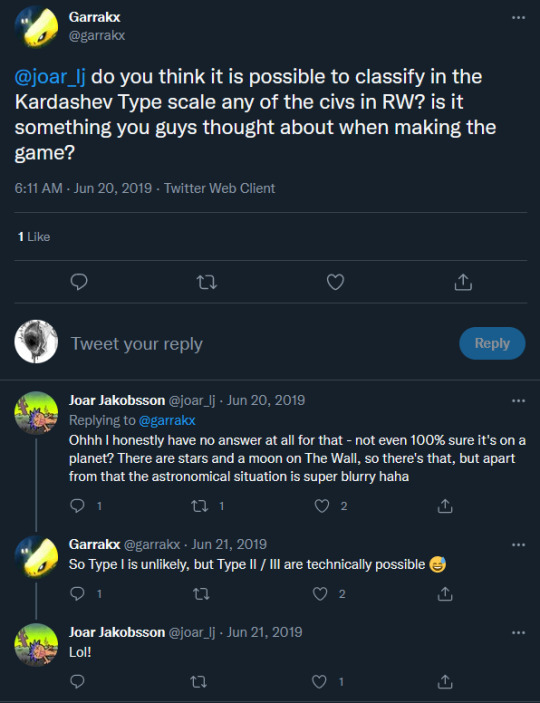
He also said on an earlier dev log how Rain World functions more like a fantasy world where it doesn’t hold much relevance than a real sci-fi like planet.
“Oh, another thing - Rain World isn't a planet lol Cheesy Or I guess it might probably be on a planet, just as Lord of The Rings, Sex And The City, Zelda and Frankenstein's Monster are probably technically on a planet, but just as in those examples the planet aspect isn't really relevant at all. Rain World is more of a fantasy world or a dream world, not somewhere you can go in a space ship ~”
But even if it’s not incredibly relevant, it’s clear a lot of thought was put into Rain Worlds fictional cosmology, this was even mentioned by James.

So, that being said here's what we know about Rain World's cosmology in game.
The biggest indicator of Rain World's unique cosmology is that the Farm Arrays deep pink pearl just mentions celestial spheres, which are aspects of older cosmological models.
"This one is just plain text. I will read it to you. "On regards of the (by spiritual splendor eternally graced) people of the Congregation of Never Dwindling Righteousness, we Wish to congratulate (o so thankfully) this Facility on its Loyal and Relished services, and to Offer our Hopes and Aspirations that the Fruitful and Mutually Satisfactory Cooperation may continue, for as long as the Stars stay fixed on their Celestial Spheres and/or the Cooperation continues to be Fruitful and Mutually Satisfactory." ...May Not as long as the Stars stay fixed on their Celestial Spheres Grey Hand, Impure Blood, Inheritable Corruption, Parasites, or malfunction settle in Your establishment."
More subtly, there's also a mention of the ground colliding with the sky.
"If you leave a stone on the ground, and come back some time later, it's covered in dust. This happens everywhere, and over several lifetimes of creatures such as you, the ground slowly builds upwards. So why doesn't the ground collide with the sky? Because far down, under the very very old layers of the earth, the rock is being dissolved or removed. The entity which does this is known as the Void Sea."
You could chalk this line up to flowery language, but considering the presentation of the rest of the dialogue, it sounds more like an actual aspect of this world.
We know from the Chimney Canopy echo that the sun rises.
"From within my vessel of flesh, I would perch upon this spot to observe the rising of the sun."
And from the top of The Wall we can see the moon and stars (confirmed to be stars by Joar in the previous screenshot, instead of satellites or something else) , which are green!

So, what does this all mean? I think we can entail a few things with what they've given us.
For one, the mention of the ground colliding with the sky implies some sort of firmament, which isn't an unusual concept in the general realm of celestial spheres.
But on the topic of celestial spheres, the pearl actually isn't the only place we see the concept. Guardian halos are very similar to depictions of celestial spheres, and also astrological clocks.
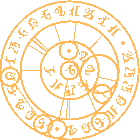
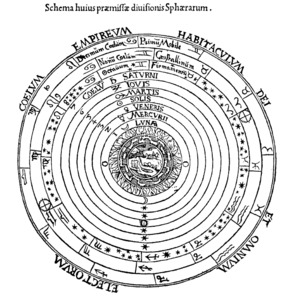
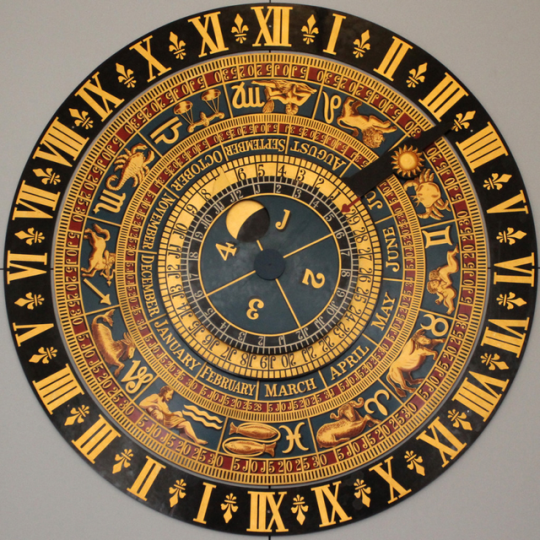
You can make of this as you will, perhaps the astrological references being tied to guardians could hint at the nature of karma, but there isn't much to really delve into that idea.
For what it's worth, celestial spheres are also core concepts in Gnosticism, which Rain World is heavily inspired by. I explain it more in this post about Void Worms, but for a quick synopsis in Gnosticism there are seven planetary spheres, and an eighth above them; the planets and stars are fixed to their spheres. These things just further cement the fact that celestial spheres seem to be a key aspect of Rain World's cosmology, and it would also likely imply it's universe follows a geocentric model.
For a bit of a more out-there theory, people have pointed out how the view atop the wall stretches really far, going far beyond what we could see on a spherical planet like Earth, which has led some to theorize that the world is also flat.
But what is probably the most important aspect of Rain World's cosmology is the nature of dust. Dust builds up, and the bedrock of the world is eaten away at by the Void Sea. Civilizations rise and fall into the sea as new ones are built above it. Many, including myself, believe that the world exists in a sort of state of equilibrium. The world is dissolved from the bottom, then that falls back on the world as dust; even in the final moments of the game we see dust suspended in the void sea depths.
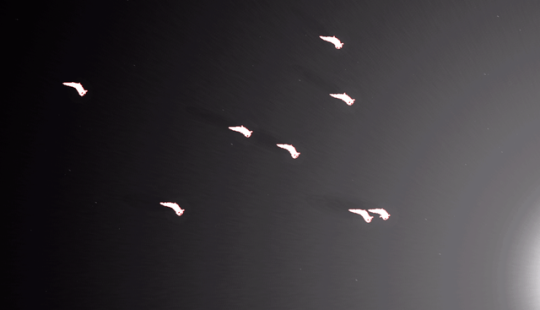
And hey, even void worms are described as being star-like.
"Oh, interesting. This is a diary entry of a pre-Iterator era laborer during the construction of the subterranean transit system south of here. In it they describe restless nights filled with disturbing dreams, where millions glowing stars move menacingly in the distance."
Cyclical, recursive, something else entirely? We can never really pin down the true nature of Rain World's cosmology, but the things we do get hint at something strange and unique. It's such an interesting aspect of the lore, and it seems like Videocult will continue to make mysterious cosmologies in their future projects...
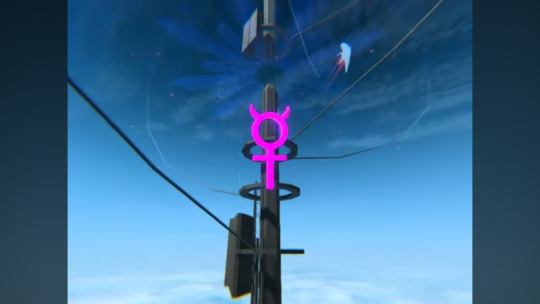

697 notes
·
View notes